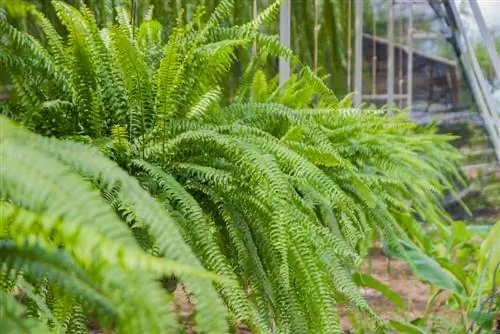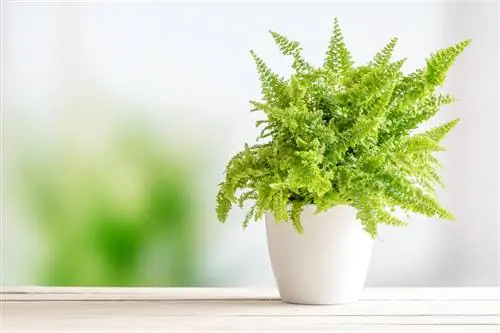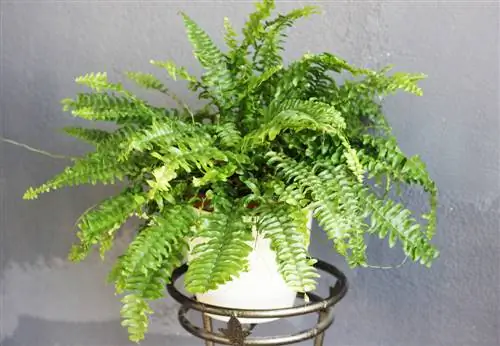- Author admin [email protected].
- Public 2023-12-25 17:45.
- Last modified 2025-06-01 06:02.
It looks particularly good in hanging baskets or in tall containers: the sword fern. With its arching, overhanging, very decorative pinnate leaves, the prehistoric plant can create a very attractive picture. Read and be amazed at what his cultivation has in store!

How do I properly care for a sword fern?
The sword fern (Nephrolepis) is an attractive, easy-care houseplant with long, arching, pinnate leaves. It prefers a bright location without direct sunlight, high humidity and temperatures suitable for living. Water and spray regularly, but avoid waterlogging.
Origin
The sword ferns, botanically Nephrolepis, form their own genus within the plant family of true ferns - and of these they are probably the most popular for ornamental gardening purposes. Regarding their origin, in addition to their current distribution area, their astonishing age must also be mentioned with just reverence. Ferns, like horsetails, are among the first and most enduring plants in our planet's flora. Millions of years ago, impressive species of ferns grew in the primeval forests, long before the flora on earth diversified.
To this day, ferns have remained in an overall reduced but still very species-rich population, so that one can only take one's hat off to their ability to survive. Today's fern species grow in tropical to subtropical areas all over the world. The genus of sword ferns occurs specifically in America - they are at home from southern Florida down to South America.
With us, sword ferns can only be cultivated as houseplants.
Origin at a glance:
- Ferns are among the first plants in the global flora
- Sword ferns at home in tropical Central to South America
- Kept in indoor culture in this country
Growth
Sword ferns, like all ferns, grow as perennials. Its characteristic appearance is characterized by the long, arching, overhanging leaves, which appear very regular and indestructible with their fine pinnation. Depending on the species, they also develop a slightly more upright habit. The leaves emerge like rosettes from the center of the plant.
In their native areas they usually grow epiphytically as epiphytes on large trees. They form a clumpy rhizome root system, which is not critical for its cultivation here - after all, a sword fern has to be kept in a pot anyway so that it cannot spread uncontrollably. However, this root characteristic obviously requires regular repotting.
Growth characteristics in keywords:
- Sword fern grows as a perennial
- Leaves emerge like rosettes and form a spreading, arching, overhanging to slightly upright habit
- Mostly growing epiphytically in native areas, i.e. as epiphytes on trees
- Form clumpy rhizome roots
leaves
The leaves of the sword fern are not only the reason for its leafy status because of their attractive structure - it is a flowerless plant, so you don't get any ornamental value from flowers anyway. To reproduce, the sword fern forms rounded, brownish spore capsules under the leaf midribs.
Like all ferns, the frond-like leaves have a typically pinnate structure and, depending on the variety, are also twisted or wavy in this genus. In total, the fronds can grow up to 1.80 m long. The individual leaves attach alternately and have different shapes from lanceolate to ovoid-rounded; the leaf edges are either finely toothed or smooth. The color is usually a light, fresh green, in some varieties also a darker medium green.
Leaf properties in brief:
- Are the only but very attractive decorative value of the flowerless sword fern
- Reproductive organs in the form of spore capsules are located on the lower leaf midribs
- Feathery structure typical of ferns with different shapes depending on the variety
- Mostly bright, fresh green
Which location is suitable?
Due to its native habitat on large trees in tropical forests, the sword fern requires a bright but not full sun location. It reacts relatively sensitively to too direct and too frequent exposure to sunlight, causing brown burn marks. If possible, give it a bright window seat or, if available, a spot in the winter garden where it is surrounded by other plants and lightly shaded. A thin curtain can also help against intense sun coming through the window.
The sword fern should not have to endure cool drafts. It needs comfortable temperatures between 19 and 22 °C, suitable for living space, but in winter it would like to be a little cooler.
From its tropical homeland, it is used to high humidity, which you should ensure somehow in your home. A sword fern, for example, thrives very well in a warm, humid bathroom - of course only if a window lets in enough light.
To remember:
- Location bright, but not full sun
- No cold drafts
- High humidity - bathroom or humid winter garden ideal
What soil does the plant need?
Sword ferns need a substrate that is as rich in humus and loose as possible and has a high water storage capacity. It is best to place it in a potting soil mixture loosened with sand, peat and perlite. A small amount of peat moss is also welcome for the epiphyte.
Watering sword fern
As a tropical plant, the sword fern loves a lot of moisture. Not only does it want to be watered regularly, but it also appreciates a shower or two on its leaves with the water disperser. This will give him a homely environment. Nevertheless, the plant reacts sensitively to waterlogging. You should always empty any excess water from the saucer as soon as possible.
Use low-lime, lukewarm, stale water for watering and especially for spraying.
To remember:
- Sword fern needs a lot of moisture, especially it likes showers of water on its leaves
- Water regularly, but avoid waterlogging
- Use low-lime, lukewarm, stale water
Fertilize sword fern properly
The nutrient requirements of sword ferns are moderate. You don't necessarily need to fertilize it, but you can if you value fresh, vital growth. During the growth phase from spring to early autumn, it is not a bad idea to give the sword fern some fertilizer every one to two weeks. To do this, use a low dosage of liquid fertilizer for green plants. Fertilizer sticks are also suitable. However, if you repot the sword fern into a fresh substrate every year, you can skip fertilizing altogether.
Propagate sword fern
As already mentioned, the sword fern is a flowerless plant and has always relied on a spreading mechanism via spores. You can also use these if you want to propagate it yourself and specifically.
Spore sowing
However, this method is a bit tricky and only works with pure sword fern species. However, it is an interesting challenge for those interested in botany. As soon as the spore capsules on the lower leaf midrib have matured brownish, cut the leaf and place it on a piece of paper for a few days. At some point the capsules will open and drop their dusty contents. Place this in planters with potting soil and moisten them well with the water disperser. Cover them with foil or, better yet, use a mini greenhouse. Germination requires high humidity, uniform ventilation and warm temperatures. If a mossy coating forms on the soil, carefully lift it off while maintaining strict hygiene and place it in a new substrate. Small sword ferns can grow from it in a bright, sunny location.
Division
Division is much easier and less time-consuming. After you have potted the sword fern, you can easily cut up the clumpy rhizome roots with a spade or a large knife. Simply place the separated piece in a new bucket with fresh substrate.
foothills
Older specimens occasionally form small runners from the rhizome roots. You can simply separate these and place them in small cultivation pots with humus-rich soil. It's best to do this in the spring.
Diseases and pests
As with all moisture-loving ornamental plants, a sword fern, especially if kept indoors all year round, can occasionally be plagued by spider mites. These parasites find ideal conditions on host plants that are weakened by too much dry heating air. It is therefore always advisable to pay close attention to high humidity and to spray it regularly in addition to watering a sword fern.
You can easily recognize spider mites by the cobweb-like webs with which they cover the leaves of their host. But the small, greenish to reddish animals can also be seen with the naked eye. The safest, most ecologically friendly and most sensible means is water. Not only does it eliminate the cause, which is usually dryness, but it is also extremely unpleasant for the mites. First, you can simply rinse them off the leaves with a stronger stream of water. Then cover the entire wet plant under a film that you tie together at the bottom. In this air-poor, moist environment, the mites usually die within a week.
Is sword fern poisonous?
Sword ferns are considered slightly poisonous. However, their content of harmful substances is so low that there is no danger to children or pets. Larger quantities would have to be consumed, and in this case the body would also get rid of the unwanted substances.
Sword ferns should be considered less dangerous than he alth-promoting: because they filter pollutants such as xylene or formaldehyde from the air and thereby ensure a better indoor climate.read more
Varieties
The two species Nephrolepis ex altata and Nephrolepis cordifolia are mainly available in specialist shops for ornamental purposes. Of these, especially Nephrolepis ex altata, there are numerous cultivars that differ from each other primarily in the length of the leaves and their pinnation.
A very classic variety is the Nephrolepis ex altata 'Green Lady'. It delights with its long leaf fronds in beautiful medium green and smooth-edged feathering. Its growth is bushy and arching, overhanging.
The leaf fronds of the Nephrolepis ex altata 'Corditas' variety are slightly more finely structured and also have a very bushy appearance.
If you have a lot of space, for example in a spacious winter garden, you can buy a Nephrolepis ex altata 'Massii': This sword fern impresses with its particularly long and wide fronds in fresh green. This makes it particularly suitable for hanging baskets or for pots in high frames.






